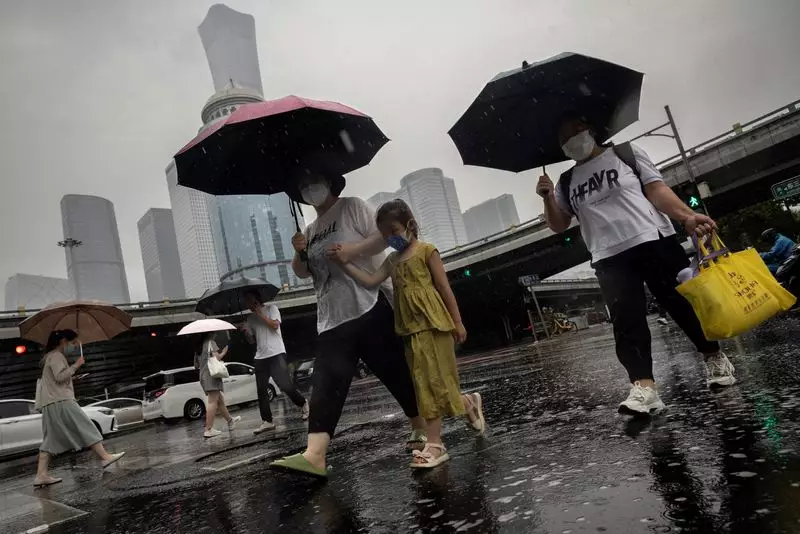As global markets breathe a sigh of relief at signs of easing inflation rates, China finds itself grappling with a distinct set of challenges. Unlike many parts of the world that are celebrating a gradual return to price stability, China’s economic landscape is overshadowed by fears of entrenched deflation. August’s inflation statistics revealed a mere 0.6% year-on-year increase in consumer prices, primarily driven by food costs, which surged due to adverse weather conditions rather than genuine demand recovery. This situation poses significant implications for China—the world’s second-largest economy—which raises concerns about its broader economic health.
Although the uptick in consumer prices could be interpreted as a positive sign, a closer examination suggests a more troubling reality. The core consumer inflation rate, which excludes volatile food and fuel prices, dropped to 0.3% in August, its lowest level in over three years. This deceleration demonstrates a waning demand among consumers, which could stifle economic activity and hamper growth initiatives. Additionally, the sharp decline in producer prices—falling by 1.8% year-on-year—further reflects the stagnation in demand for goods and services, implicitly signaling troubling times ahead for manufacturers and suppliers.
The principal drivers of these issues seem to revolve around a self-perpetuating cycle of deflation. Analysts from Morgan Stanley go so far as to highlight the dire consequences of this cycle, suggesting that stagnant wages could lead to diminished spending power for consumers, ultimately rippling through other sectors and resulting in lower corporate revenues and increased layoffs.
To underscore the potential dangers that follow deflation, it is instructive to look back at Japan in the 1990s. Following a turbulent economic era marked by rapid growth post-World War II, Japan entered a period known as the “lost decades,” characterized by stagnant growth and deflationary pressures that proved remarkably resistant to reversal. These historical lessons ring alarmingly true for China today, with analysts warning that if not addressed, the country may be on a similar trajectory of enduring economic stagnation.
This challenge stands not merely as an economic forecast, but as a clarion call for immediate and exhaustive intervention by policymakers. The necessity for decisive action to avert an analogous trajectory to Japan’s is critical, with calls for the Chinese government to unleash substantial financial stimuli and reform measures.
In light of mounting economic turbulence, Beijing has taken proactive measures by channeling funds into the industrial sector, aiming to kindle economic activity and bolster employment. However, the paradox lies in the fact that this increase in supply has not corresponded with an uptick in demand, thereby perpetuating the cycle of deflation rather than alleviating it. Morgan Stanley’s analysts emphasize that the limited short-term benefits for employment and income are insufficient to rejuvenate consumer spending, which remains a cornerstone of economic vitality.
Looking forward, China has set an ambitious target of achieving 5% real gross domestic product growth in 2024. Yet, the specter of deflation looms perilously over this goal, particularly as reduced demand encroaches upon investment and overall growth prospects. Policymakers are now contemplating fiscal support directed at critical sectors like housing and social welfare to stabilize a faltering economy.
It is crucial to understand that China’s deflationary challenges are not self-contained; they exert transnational effects, radiating disinflationary pressure onto global markets. As one of the world’s major trading hubs, China’s economic struggles ripple into the United States and the Eurozone, contributing to a slight decrease in core inflation rates—approximately by 0.1 percentage points in these regions, an outcome defined as significant given the current context of monetary policy adjustments.
This interconnectedness illustrates the daunting challenge posed by China’s economic conundrum, wherein the resolution of its domestic struggles could very well hinge upon an intricate web of global economic factors. As central banks regroup to contemplate fresh cycles of interest rate reductions, the ripple effects of China’s economic state are bound to become an intricate topic of discussion in the wider context of global financial policy.
China’s battle with deflation encapsulates a complex interplay of economic dilemmas that require prompt, decisive action from its policymakers. The historical lessons from Japan serve as a cautionary tale, advocates for vigilance in crafting strategies that foster genuine demand recovery and safeguard against prolonged economic stagnation.

